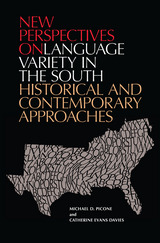
Beginning with an introduction to American Indian languages of the Southeast, five fascinating essays discuss indigenous languages, including Caddo, Ofo, and Timucua, and evidence for the connection between the Pre-Columbian Southeast and the Caribbean.
Five essays explore the earlier Englishes of the South, covering topics such as the eighteenth century as the key period in the differentiation of Southern American English and the use of new quantitative methods to trace the transfer of linguistic features from England to America. They examine a range of linguistic resources, such as plantation overseers’ writings, modern blues lyrics, linguistic databases, and lexical and locutional compilations that reveal the region’s distinctive dialectal traditions.
New Perspectives on Language Variety in the South: Historical and Contemporary Approaches widens the scope of inquiry into the linguistic influences of the African diaspora as evidenced in primary sources and records. A comprehensive essay redefines the varieties of French in Louisiana, tracing the pathway from Colonial Louisiana to the emergence of Plantation Society French in a diglossic relationship with Louisiana Creole. A further essay maps the shift from French to English in family documents.
An assortment of essays on English in the contemporary South touch on an array of compelling topics from discourse strategies to dialectal emblems of identity to stereotypes in popular perception.
Essays about recent Latino immigrants to the South bring the collection into the twenty-first century, taking into account the dramatic increase in the population of Spanish speakers and illuminating the purported role of “Spanglish,” the bilingual lives of Spanish-speaking Latinos in Mississippi, and the existence of regional Spanish dialectal diversity.

Thirty-three million people in the United States speak some variety of Spanish, making it the second most used language in the country. Some of these people are recent immigrants from many different countries who have brought with them the linguistic traits of their homelands, while others come from families who have lived in this country for hundreds of years. John M. Lipski traces the importance of the Spanish language in the United States and presents an overview of the major varieties of Spanish that are spoken there.
Varieties of Spanish in the United States provides—in a single volume—useful descriptions of the distinguishing characteristics of the major varieties, from Cuban and Puerto Rican, through Mexican and various Central American strains, to the traditional varieties dating back to the sixteenth and eighteenth centuries found in New Mexico and Louisiana. Each profile includes a concise sketch of the historical background of each Spanish-speaking group; current demographic information; its sociolinguistic configurations; and information about the phonetics, morphology, syntax, lexicon, and each group's interactions with English and other varieties of Spanish. Lipski also outlines the scholarship that documents the variation and richness of these varieties, and he probes the phenomenon popularly known as "Spanglish."
The distillation of an entire academic career spent investigating and promoting the Spanish language in the United States, this valuable reference for teachers, scholars, students, and interested bystanders serves as a testimony to the vitality and legitimacy of the Spanish language in the United States. It is recommended for courses on Spanish in the United States, Spanish dialectology and sociolinguistics, and teaching Spanish to heritage speakers.
READERS
Browse our collection.
PUBLISHERS
See BiblioVault's publisher services.
STUDENT SERVICES
Files for college accessibility offices.
UChicago Accessibility Resources
home | accessibility | search | about | contact us
BiblioVault ® 2001 - 2024
The University of Chicago Press









